Balearen |
|
|
|
| Übersicht – Contents: | |
Balearen |
|
|
|
| Übersicht – Contents: | |
Flagge – Flag: |
|
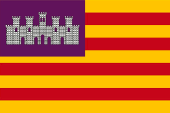 |
seit/since 1983, |
| historische und andere Flaggen – historical and other Flags: | |
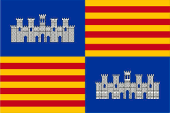 |
1229–1715, |
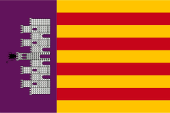 |
1978–1983, |
| Flaggen der jeweiligen Inseln – Flags of each island: | |
| Mallorca – Majorca: | |
 |
seit/since 1983, |
| Menorca (Minorca): | |
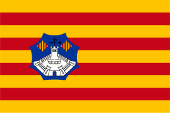 |
seit/since 1983, |
| Ibiza (Eivissa): | |
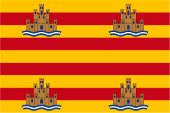 |
seit/since 1983, |
| Formentera: | |
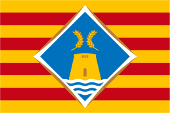 |
seit/since 2010, |
| Die heutige Flagge der Balearen wurde am 25.02.1983 offiziell eingeführt. Sie zeigt vier horizontale rote Streifen auf goldenem Grund und eine violette Oberecke in der eine Burg zu sehen ist. Das Motiv erinnert an die historische Flagge des Königreichs Mallorca. Im Jahre 1228 eroberte Jakob I., König von Aragon, die Insel Mallorca, bis 1232 war die Eroberung der Balearen abgeschlossen. Jakob I. gliederte die Inselgruppe als Königreich Mallorca seinem Herrschaftsgebiet an, er war der erste König von Mallorca. Die aus dieser Zeit überlieferten Wappen zeigten im Geviert vier senkrechte rote Streifen auf goldenem Grund (Aragon) und ein blaues Feld mit einer weißen Burg darin, was sich auch so auf Flaggen oder Bannern widerspiegelte, mal mit senkrechten mal mit waagerechten roten Linien. Diese Burg ist die Burg von Palma, der Almudaina Burgpalast, auch Almoraina genannt. Es ist ein in Palma seit der Zeit der Römer ein befestigter Platz in strategisch günstiger Lage. Die Araber (Mauren) errichteten hier im 10. Jahrhundert ihre Residenz, den Alcazar-Palast. Unter König Jakob II. wurde der Alcazar von 1305 bis 1314 zur Königsburg – dem heutigen Almudaina-Palast – umgebaut. Er dient noch heute als Residenz des Spanischen Königs wenn er auf Mallorca weilt. Im Jahre 1269 gestatte König Jakob I. der Universität von Palma seine eigene Flagge und sein eigenes Wappen zu verwenden. Als er 1276 starb, vererbte er sein Reich an seine beiden Söhne. Aragon verblieb bei seinem älteren Sohn Peter III., während sein jüngerer Bruder Jakob II. das Königreich Mallorca erbte und dazu noch die Grafschaften Roselló (Roussillon) und Cardanya (Cerdagne) und die Herrschaft Montpeller (Montpellier). Seine Hauptstadt wurde Perpinyá (Perpignan) in Roselló. Er übernahm das Wappen seines Vaters, jedoch zeigen die historischen Abbildungen von Wappen oder Bannern einen kleinen Unterschied. Die Anzahl der roten Balken verringerte sich auf drei. Flaggen oder Wappen mit diesem Bild nennt man heute "Tribarrada". Die Ursachen dafür sind nicht bekannt. Entweder wurde dem Abzählen der aragonesischen Balken damals keine Bedeutung beigemessen, oder Jakob II. war es wichtig eine eigene Heraldik zu schaffen, die sich von der seines Bruders unterschied. Ein weiteres heraldisches Bild, das mit dem Königreich Mallorca in Verbindung gebracht wird ist das übliche Wappen von Aragon mit den vier roten senkrechten Balken auf Gold, jedoch mit einem darüber gelegten blauen Schrägbalken. Es taucht auf frühen historischen Abbildungen nicht auf, aber in der Renaissance, als heraldisches Emblem anlässlich der Beerdigung von Karl I. von Spanien im Jahr 1558. Auch das ist rätselhaft, vor allem weil dieses Wappenbild heute als Wappen des Königreichs Mallorca gilt. Aber, es war in der Heraldik üblich, nicht legitime, vom Erbe ausgeschlossene Seiten- und Nebenlinien einer Familie in den Wappen durch einen sogenannten "Bastardfaden" zu kennzeichnen, der schräg über das Familienwappen gelegt wurde. Jakob II. war der jüngere Sohn, Peter III. der ältere. Peters Dynastie wird alles getan haben um Jakob und seine Nachfolger von der Erbfolge (vor allem in Aragon) auszuschließen. Tatsächlich haben sie den Besitz von Jakob II. noch nicht mal anerkannt und seinen Erbteil stets streitig gemacht. Wie dieses Wappen 1978 zum Wappen der Balearen werden konnte ist ebenfalls rätselhaft. Mit König Sancho, er regierte von 1311 bis 1324, wird eine weitere legendäre Flagge in Verbindung gebracht, die er angeblich geschaffen haben soll. Sie zeigte die vier roten Balken auf Gold und in senkrechter Ausrichtung dazu, jedoch am Liek bzw. oben einen breiten blauen Balken über die gesamte Breite, mit einer weißen Burg darin. Diese Flagge, wahrscheinlich eine Erfindung neuerer Zeit, wurde dann zum Vorbild gewählt, als es 1978 darum ging für die neu zu schaffende autonome Region Balearen eine Flagge zu gestalten. Unter der der Regierung des Generals Franco (1936–1975) waren alle regionalen Flaggen verboten. Nach Francos Tod (1975) wurden die regionalen Flaggen wieder eingeführt oder neu geschaffen, auch auf den Balearen, wenn auch zunächst inoffiziell, weil die Balearen bis 1983 noch keinen Autonomiestatus hatten. Im Jahre 1978 wurde eine Flagge angenommen, die der Sancho-Flagge ähnelte, lediglich der Balken mit der Abbildung der Burg erschien anstelle in Blau in Violett. Als die Balearen 1983 die Autonomie erhielten, wurde die heutige Flagge eingeführt und die vorher gültige Flagge offiziell von der Insel Mallorca übernommen. Auf dieser Flagge erscheint auf den Zinnen des Mittelturmes ein Engel mit einem Krummstab. Diese Engelsgestalt, die in Wirklichkeit an der Außenseite des Hauptturmes eingemeißelt ist, erscheint heute meist in Schwarz auf den Flaggen von Mallorca, jedoch auch in Weiß und einige Flaggen zeigen sie gar nicht. |
The current flag of the Balearic Islands was officially introduced on 25th
of February 1983. It shows four horizontal red stripes on a golden
background and a purple upper corner in which a castle can be seen. The
motif is reminiscent of the historical flag of the Kingdom of Mallorca. In 1228, James I, King of Aragon, conquered the island of Mallorca, and by 1232 the conquest of the Balearic Islands was complete. James I incorporated the archipelago into his domain as the Kingdom of Mallorca, and he was the first king of Mallorca. The coats of arms that have survived from this time show in quad four vertical red stripes on a golden background (Aragon) and a blue field with a white castle in it, which is also reflected on flags or banners, sometimes with vertical and sometimes with horizontal red lines. This castle is the castle of Palma, the Almudaina Castle Palace, also called Almoraina. It has been a fortified place in Palma since Roman times, in a strategic position. The Arabs (Moors) built their residence, the Alcazar Palace, here in the 10th century. Under King James II, the Alcazar was converted into the royal castle – today's Almudaina Palace – from 1305 to 1314. It still serves as the Spanish king's residence when he is in Mallorca. In 1269, King James I allowed the University of Palma to use its own flag and its own coat of arms. When he died in 1276, he bequeathed his kingdom to his two sons. Aragon remained with his elder son Peter III, while his younger brother James II inherited the kingdom of Mallorca, plus the Counties of Roselló (Roussillon) and Cardanya (Cerdagne) and the Dominion of Montpeller (Montpellier). His capital became Perpinyá (Perpignan) in Roselló. He took over his father's coat of arms, but the historical images of coats of arms or banners show a slight difference. The number of red bars decreased to three. Flags or coats of arms with this image are now called "tribarrada". The reasons for this are not known. Either no importance was attached to counting the Aragonese bars at that time, or James II was keen to create his own heraldry, different from that of his brother. Another heraldic image associated with the Kingdom of Mallorca is the usual coat of arms of Aragon with the four red vertical bars on gold, but with a blue slanting bar superimposed. It does not appear in early historical images, but in the Renaissance, as a heraldic emblem on the occasion of the funeral of Charles I of Spain in 1558. This is also puzzling, especially because this heraldic image is now considered the coat of arms of the Kingdom of Mallorca. But, it was customary in heraldry to mark non-legitimate side and bylines of a family excluded from inheritance in the coats of arms by a so-called "bastard thread" placed diagonally across the family coat of arms. Jacob II was the younger son, Peter III the elder. Peter's dynasty will have done all they could to exclude James and his successors from the succession (especially in Aragon). In fact, they did not even recognise the possession of James II and always disputed his inheritance. How this coat of arms could become the coat of arms of the Balearic Islands in 1978 is also a mystery. King Sancho, who ruled from 1311 to 1324, is associated with another legendary flag that he is said to have created. It showed the four red bars on gold and in perpendicular alignment to them, but at the leech or top a broad blue bar across the entire width, with a white castle in it. This flag, probably an invention of more recent times, was then chosen as a model when it came to designing a flag for the newly to create autonomous region of the Balearic Islands in 1978. Under the government of General Franco (1936-1975), all regional flags were banned. After Franco's death (1975), regional flags were reintroduced or newly created, also in the Balearic Islands, although unofficially at first, because the Balearic Islands did not have autonomous status until 1983. In 1978, a flag was adopted that resembled the Sancho flag, only the bar with the image of the castle appeared in purple instead of blue. When the Balearic Islands gained autonomy in 1983, the current flag was introduced and the flag previously in force was officially adopted by the island of Mallorca. On this flag, an angel with a crook appears on the battlements of the central tower. This angelic figure, which is actually carved on the outside of the main tower, now appears mostly in black on the flags of Mallorca, but also in white and some flags do not show it at all. |
| Quelle/Source: Wikipedia (ES), Flags of the World, teapartybalear.blogspot.com, Volker Preuß | |
Wappen – Coat of Arms: |
|
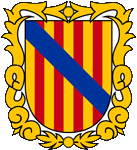 |
seit/since 1984, Wappen der Balearen – coat of arms of the Balearic Islands, Quelle/Source, nach/by: Wikipedia (ES) |
historische Wappen – historical Coats of Arms: |
|
 |
Wappen des Königreichs Mallorca – coat of arms of the Kingdom of Majorca, Quelle/Source, nach/by: fuenterrebollo.com |
 |
Wappen des Königreichs Mallorca – coat of arms of the Kingdom of Majorca, Quelle/Source, nach/by: teapartybalear.blogspot.com |
 |
Wappen des Königreichs Mallorca – coat of arms of the Kingdom of Majorca, Quelle/Source, nach/by: Wikipedia (ES) |
| Das heutige Wappen der Balearen wurde am 21.11.1984 offiziell eingeführt. Das Schild zeigt das Wappen Aragoniens von 1150 (vier rote Balken auf Gold) ergänzt um einen blauen Schrägbalken. Die Farben Rot und Gold gehen angeblich auf den Einfluss des Papstes zurück, denn das alte Königreich Aragon und die Grafschaft Barcelona waren Lehen des Heiligen Stuhls, und verwendeten deshalb die Farben der Stadt Rom. Dieses Wappen taucht auf frühen historischen Abbildungen nicht auf, aber in der Renaissance, als heraldisches Emblem anlässlich der Beerdigung von Karl I. von Spanien im Jahr 1558. Auch das ist rätselhaft, vor allem weil dieses Wappenbild heute als Wappen des Königreichs Mallorca gilt. Aber, es war in der Heraldik üblich, nicht legitime, vom Erbe ausgeschlossene Seiten- und Nebenlinien einer Familie in den Wappen durch einen sogenannten "Bastardfaden" zu kennzeichnen, der schräg über das Familienwappen gelegt wurde. Jakob II. war der jüngere Sohn, Peter III. der ältere. Peters Dynastie wird alles getan haben um Jakob und seine Nachfolger von der Erbfolge (vor allem in Aragon) auszuschließen. Tatsächlich haben sie den Besitz von Jakob II. noch nicht mal anerkannt und seinen Erbteil stets streitig gemacht. Wie dieses Wappen 1978 zum Wappen der Balearen werden konnte ist rätselhaft. Im Jahre 1228 eroberte Jakob I., König von Aragon, die Insel Mallorca, bis 1232 war die Eroberung der Balearen abgeschlossen. Jakob I. gliederte die Inselgruppe als Königreich Mallorca seinem Herrschaftsgebiet an, er war der erste König von Mallorca. Die aus dieser Zeit überlieferten Wappen zeigten im Geviert vier senkrechte rote Streifen auf goldenem Grund (Aragon) und ein blaues Feld mit einer weißen Burg darin. Diese Burg ist die Burg von Palma, der Almudaina Burgpalast, auch Almoraina genannt. Es ist ein in Palma seit der Zeit der Römer ein befestigter Platz in strategisch günstiger Lage. Die Araber (Mauren) errichteten hier im 10. Jahrhundert ihre Residenz, den Alcazar-Palast. Unter König Jakob II. wurde der Alcazar von 1305 bis 1314 zur Königsburg – dem heutigen Almudaina-Palast – umgebaut. Er dient noch heute als Residenz des Spanischen Königs wenn er auf Mallorca weilt. Im Jahre 1269 gestatte König Jakob I. der Universität von Palma seine eigene Flagge und sein eigenes Wappen zu verwenden. Als er 1276 starb, vererbte er sein Reich an seine beiden Söhne. Aragon verblieb bei seinem älteren Sohn Peter III., während sein jüngerer Bruder Jakob II. das Königreich Mallorca erbte und dazu noch die Grafschaften Roselló (Roussillon) und Cardanya (Cerdagne) und die Herrschaft Montpeller (Montpellier). Seine Hauptstadt wurde Perpinyá (Perpignan) in Roselló. Er übernahm das Wappen seines Vaters, jedoch zeigen die historischen Abbildungen von Wappen oder Bannern einen kleinen Unterschied. Die Anzahl der roten Balken verringerte sich auf drei. Flaggen oder Wappen mit diesem Bild nennt man heute "Tribarrada". Die Ursachen dafür sind nicht bekannt. Entweder wurde dem Abzählen der aragonesischen Balken damals keine Bedeutung beigemessen, oder Jakob II. war es wichtig eine eigene Heraldik zu schaffen, die sich von der seines Bruders unterschied. |
The current coat of arms of the Balearic Islands was officially introduced
on 21.11.1984. The shield shows the arms of Aragon from 1150 (four red bars
on gold) supplemented by a blue slanting bar. The colours red and gold are
said to be due to the influence of the Pope, as the old kingdom of Aragon
and the county of Barcelona were fiefs of the Holy See, and therefore used
the colours of the city of Rome. This coat of arms does not appear in early historical illustrations, but it did in the Renaissance, as a heraldic emblem on the occasion of the funeral of Charles I of Spain in 1558. This is also puzzling, especially because this coat of arms is now considered the coat of arms of the Kingdom of Mallorca. But, it was customary in heraldry to mark non-legitimate side and collateral lines of a family excluded from inheritance in the arms by a so-called "bastard thread" placed diagonally across the family coat of arms. Jacob II was the younger son, Peter III the elder. Peter's dynasty will have done all they could to exclude James and his successors from the succession (especially in Aragon). In fact, they did not even recognise the possession of James II and always disputed his inheritance. How this coat of arms became the coat of arms of the Balearic Islands in 1978 is a mystery. In 1228, James I, King of Aragon, conquered the island of Mallorca, and by 1232 the conquest of the Balearic Islands was complete. James I annexed the archipelago to his domain as the Kingdom of Mallorca, and was the first king of Mallorca. The coats of arms that have survived from this time show four vertical red stripes on a golden background (Aragon) and a blue field with a white castle in it. This castle is the castle of Palma, the Almudaina Castle Palace, also called the Almoraina. It has been a fortified place in Palma since Roman times, in a strategic position. The Arabs (Moors) built their residence, the Alcazar Palace, here in the 10th century. Under King James II, the Alcazar was converted into the royal castle - today's Almudaina Palace - from 1305 to 1314. It still serves as the Spanish king's residence when he is in Mallorca. In 1269, King James I allowed the University of Palma to use its own flag and coat of arms. When he died in 1276, he bequeathed his kingdom to his two sons. Aragon remained with his elder son Peter III, while his younger brother James II inherited the kingdom of Mallorca, plus the counties of Roselló (Roussillon) and Cardanya (Cerdagne) and the lordship of Montpellier. His capital became Perpinyá (Perpignan) in Roselló. He adopted his father's coat of arms, but the historical images of coats of arms or banners show a slight difference. The number of red bars was reduced to three. Flags or coats of arms with this image are now called "tribarrada". The reasons for this are not known. Either no importance was attached to counting the Aragonese bars at the time, or James II was keen to create his own heraldry, different from that of his brother. |
| Quelle/Source: Wikipedia (ES), teapartybalear.blogspot.com, Volker Preuß | |
|
Die autonomen Regionen Spaniens – The autonomous Regions of Spain: Interaktive Landkarte - interactive map |
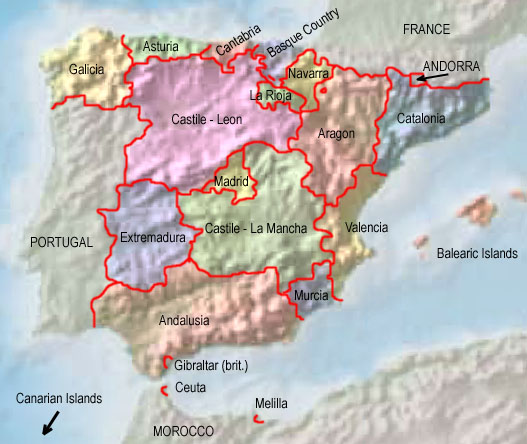 |
| Quelle/Source: Freeware, University of Texas Libraries, modyfied by: Volker Preuß |
| Zahlen und Fakten – Numbers and Facts: | |
|
|
|
|
|
|
|
|
|
|
|
|
|
|
|
|
|
4. Jahrtausend v.Chr. · Besiedlung der Inseln 11.–7. Jhd. v.Chr. · die Inseln sind eine Kolonie Phöniziens 3. Jhd. v.Chr. · die Inseln sind eine Kolonie Kathagos 123 v.Chr. · der Konsul Quintus Caecilius Metellus erobert die Inseln (Balearides genannt) für das Römische Reich, sie werden später der Provinz Hispania Tarraconensis angeschlossen, Besiedlung durch Baetiker aus dem Süden Iberischen Halbinsel, Gründung der Städte Palma und Polentia auf Mallorca 425 n.Chr. · die Vandalen unter Gunderich erobern die Inseln 560 · das Oströmische Reich (Byzanz) erobert die Inseln 798 · die Araber erobern die Balearen, zum Emirat von Córdoba (ab 929 Arabisches Kalifat Córdoba unter der Herrschat der Dynastie der Omajjaden 1010 · Sturz der Omajjaden-Dynastie, bis 1040 Zerfällt das Kalifat von Córdoba in mehrere arabische Königreiche (Malaga, Algeciras, Granada, Cordoba, Toldeo, Valencia, Zaragoza, Denia, Murcia und Badajoz), die Balearen kommen zum Königreich Medina bu Taral (Valencia) 1220 · die Balearen trennen sich von Medina bu Taral und werden von einem eigenen maurischen König beherrscht 1228 · Jakob I. von Aragonien erobert Mallorca 1232 · Jakob I. von Aragonien erobert Menorca und Ibiza, Jakob I. gründet das Königreich Mallorca 1232–1343 · Regierungszeit der Könige von Mallorca (Jakob I., Sancho und Jakob II.) 1276 · Tod von König Jakob I. von Aragonien, das Erbe geht an seine beiden Söhne, Aragonien geht an seinen älteren Sohn Peter III., sein jüngerer Bruder Jakob II. erbt das Königreich Mallorca und dazu noch die Grafschaften Roselló (Roussillon) und Cardanya (Cerdagne) und die Herrschaft Montpeller (Montpellier), Hauptstadt des Königreichs Mallorca wird Perpinyá (Perpignan) in Roselló 1343 · König Peter IV. von Aragonien erobert das Königreich Mallorca in den Peterskriegen (Thronfolgekriege), das Königreich Mallorca verbleibt bis 1714 als ein Teil der vereinigten Krone von Aragonien 1469 · Heirat von König Ferdinand II. von Aragonien mit Isabella, der Thronerbin von Kastilien-Leon 1479 · Krönung von Ferdinand II. und Isabella I. zu Königen von Spanien 1516 · offizielle Vereinigung von Aragonien und Kastilien-Leon, Aragonien behält jedoch wichtige Pivilegien 1609 · König Philipp III. verweist die letzten Moslems (Morisken) des Landes 1701–1714 · Spanischer Erbfolgekrieg, Großbritannien besetzt 1708 die Insel Menorca, Aragonien ergreift für Östrereich Partei, nach der Niederlage Verlust der Privilegien, Ende des selbstständigen Königtums der Vereinigten Krone von Aragonien, Katalonien, die Balearen und Valencia werden als spanische Provinzen ausgegliedert 1713 · Frieden von Utrecht, Spanien tritt Menorca offiziell an Großbritannien ab 1783 · Frieden von Versailles nach dem amerikanischen Unabhängigkeitskrieg, Großbritannien muss Menorca an Spanien zurückgeben 1798–1802 · Großbritannien besetzt erneut die Insel Menorca 1808–1812 · die Balearen sind durch französische Truppen besetzt 1931 · Autonomie-Status für die Balearen wird erstmals vorgeschlagen 1936–1939 · Spanischer Bürgerkrieg, die Balearen sind von Anfang an in der Hand der Franco-Truppen und werden eine wichtige Basis im Kampf gegen die sozialistische Zentralregierung 01.03.1983 · die Balearen erhalten das Autonomiestatut innerhalb Spaniens (ehemalige Provinz Palma), Gründung der "Autonomen Gemeinschaft Balearen" |
|
4th millenary B.C. · settlement of the islands 11th–7th cent. B.C. · the islands are a colony of Phenicia 3th cent. B.C. · the islands are a colony of Cathago 123 B.C. · consul Quintus Caecilius Metellus conquers the islands (called Balearides) for the Roman Empire, they come later to the province Hispania Tarraconensis, settlement by Baetiks from the south of the Iberian Peninsula, foundation of the towns Palma and Polentia on Mallorca Island 425 A.D. · the Vandals under Gunderich conquer the islands 560 · the East Roman Empire Reich (Byzantium) conquers the islands 798 · the Arabs conquer the Balearic Islands, to the Emirate of Córdoba (since 929 Arabian Califate of Cordoba under the dynasty of the Omajjads) 1010 · overthrow of the Omajjads dynasty, to 1040 disintegrates the empire in some arabian kingdoms (Malaga, Algeciras, Granada, Cordoba, Toldeo, Valencia, Zaragoza, Denia, Murcia and Badajoz), the Balearic Islands come to the Kingdom Medina bu Taral (Valencia) 1220 · the Balearic Islands separate from Medina bu Taral and they are ruled by an own moresque king 1228 · Jacob I. of Aragon conquers Majorca 1232 · James I of Aragon conquers Menorca and Ibiza and founds the Kingdom of Majorca 1232–1343 · times of the rule of the Kings of Mallorca (Jacob I., Sancho and Jacob II.) 1276 · Death of King James I of Aragon, the inheritance goes to his two sons, Aragon goes to his elder son Peter III, his younger brother James II inherits the Kingdom of Majorca and in addition the counties of Roselló (Roussillon) and Cardanya (Cerdagne) and the Dominion of Montpeller (Montpellier), capital of the Kingdom of Majorca becomes Perpinyá (Perpignan) in Roselló 1343 · King Peter IV of Aragon conquers the Kingdom of Mallorca in the Wars of Peter (Wars of Succession), the Kingdom of Mallorca remains as a part of the united Crown of Aragon until 1714 1469 · marriage of king Ferdinand II. of Aragon with Isabella, the throne heiress of Castile-Leon 1479 · coronation of Ferdinand II. and Isabella I. to kings of Spain 1516 · official unification of Aragon and Castile-Leon, but Aragon withholds important privileges 1609 · king Philipp III. of Spain banishes the last Muslims (Moresques) out of the country 1701–1714 · Spanish succession war, United Kingdom occupies Minorca Island in 1708, Aragon positiones itself at the side of Austria, after the defeat loss of the privileges, end of the independent kingship of the United Crown of Aragon, Catalonia, the Balearic Islands and Valencia become outsourced as Spanish provinces 1713 · Peace of Utrecht, Spain cedes Minorca official to United Kingdom 1783 · Peace of Versailles after the American Independence War, United Kingdom has to give Minorca back to Spain 1798–1802 · United Kingdom occupies Minorca Island again 1808–1812 · the Balearic Islands are occupied by French troops 1931 · autonomy statute for the Balearic Islands is proposed for the first time 1936–1939 · Spanish Civil War, the Balearic Islands are from the beginning on in the hands of the troops of General Franco and become an important base in the struggle against the socialistic central government 1st of March 1983 · the Balearic Islands get the statute of autonomy within Spain (former province of Palma), establishment of the "Autonomous Community of the Balearic Islands" |
| Quelle/Source: Wikipedia (ES), World Statesmen, RetroBib Retrobibliothek, Volker Preuß |
| Der Name der Inselgruppe der Balearen geht auf die Antike zurück. Die Einwohner der Inseln waren als äußerst geschickte Steinschleuderer berühmt, die sich damit als Söldner auf den Schlachtfeldern der Antike verdingten. In dem Name Balearen (in der Antike Balearides) erkennt man daher das griechische Wort Ballistik. Ältere deutsche Lexika nennen die Inseln auch "Schleudererinseln". |
The name of the archipelago of the Balearic Islands has its roots in the
antiquity. The inhabitants of the islands were famous as very skilled
stone-hurlers which served as mercenaries on the battlefields of the
antiquity. In the name of the Balearic Islands (in the antiquity Balearides) is thats why to recognize the Greek word "ballistics". Older German lexica call the islands "Hurlers Islands" too. |
| Quelle/Source: RetroBib Retrobibliothek, Volker Preuß | |